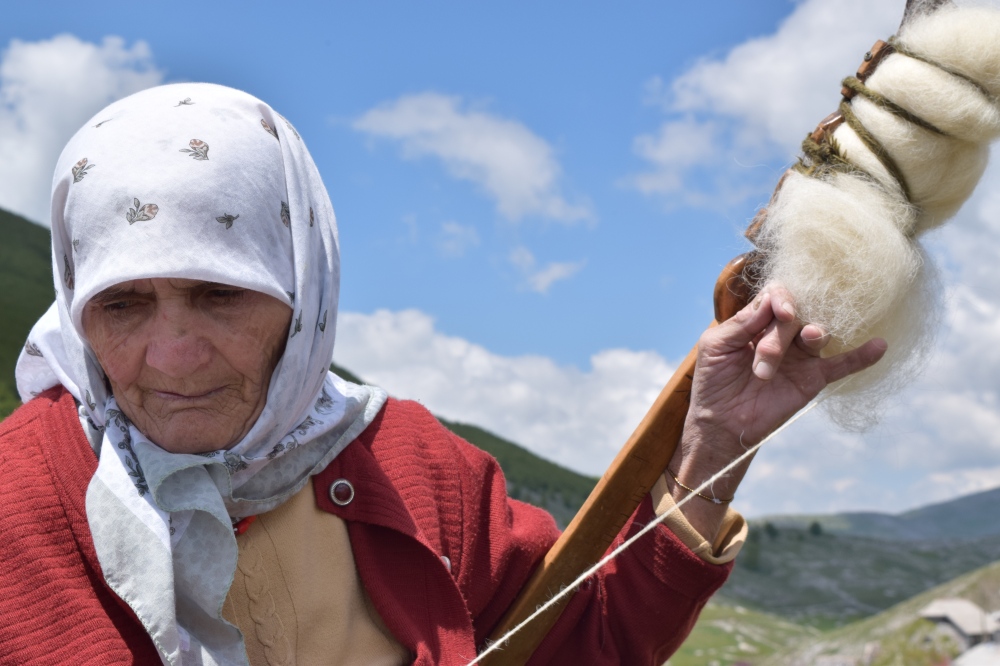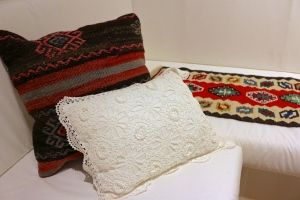Bosnia’s rich textile tradition is emblematic of the cultural aesthetic of Bosnia and Herzegovina. Textiles are often ornate and geometric in design, featuring bright and warm colors. In the villages of Bosnia prior to the war, the textile tradition developed out of a daily need. Items were made from those materials found or raised locally. Textiles could also provide extra household income.
While life in Bowling Green no longer necessitates making one’s own textiles, many still hold memories of helping in their creation. For example, many remember it was the child’s task to prepare wool for knitting socks. While there are fewer active makers in Bowling Green today, handmade items remain highly valued, and it is common to seek out textiles from Bosnia. From the crocheted Srebrenica flower and table runners to knitted socks and woven rugs, from needlepoint pillows and wall decorations to traditional clothing worn for special occasions, textiles are an outward expression of a Bosnian aesthetic.
Ćilim

Traditional Bosnian ćilim are woven rugs, usually made with a cotton warp and wool weft, featuring geometric designs. The rug in the photograph above is not woven, however its design resembles the woven rugs of Bosnia.

Below is a photo of ćilim rugs hanging for sale in Bosnia.

Heklanje

Crocheting is another form of textile work that flourishes in Bosnia. Many members of the Bosnian community in Bowling Green have crocheted pieces that were made by family members or loved ones, sometimes given as gifts for weddings or other special occasions. Many drape crocheted doilies for decoration throughout their home: over chair backs, tables, shelves, and televisions.

The crochet tradition is so beloved that a crocheting association, Gračaničko keranje (“Gračanica Crochet”), was founded in Bosnia to conserve Bosnia’s traditional crocheting techniques. Work by Gračaničko keranje has been featured in an exhibition at the National Museum of BiH (Bosnia & Herzegovina) in Sarajevo, Bosnia. Gračaničko keranje also created the Srebrenica Flower that is worn throughout Bosnia and the Bosnian diaspora to commemorate the Srebrenica Genocide of July 11, 1995.

Vunene carape

“They’re made of sheep wool and they are handmade. Actually my grandmother made them for me [. . .] a lot of Bosnian population that lived [. . .] lived in villages, that’s what would they do. To keep sheep clean they would cut off all the wool during the summer months, and actually weave it. [. . .] Usually women would, during the winter months when there’s no nothing to do in the fields, make these socks from the wool that they had.” – Nermin Peimanović
Click here for the transcription of this audio clip.
Although members of Bowling Green’s Bosnian community no longer raise sheep to spin wool, many still have knitted wool socks, or vunene carape, made by family members or purchased from Bosnia. When entering a Bosnian home, the custom is to remove ones shoes, and some families may opt to slip on a pair of knitted socks to wear around the house.
Below are some photos taken of a woman in Bosnia spinning wool to make socks. In the photos, you can get a sense of the process of spinning wool — the tools required, the techniques used — as well the variety of socks made. The photos are by WKU Folk Studies faculty Kate Horigan and were taken during a university-sponsored trip to Bosnia in the summer of 2017.







Needlepoint

Needlepoint is another form of textile craft that has a history in Bosnia and Herzegovina. Fata Hotilovac is a member of Bowling Green’s Bosnia community, who continues to create needlepoint pieces.
Needlepoint is also often represented in folklore dance performances. Young children performing in folklore dance groups will sometimes enact a variety of practices associated with traditional Bosnian lifeways, such as needlepoint, weaving, making coffee, and making pita. Below is a photo of Sanida Palavra as a young girl dressed in folklore clothing and showing off needlepoint at her elementary school in Sarajevo, Bosnia and Herzegovina.

Featured Image:
 Photo by Nicole Musgrave, 2017
Photo by Nicole Musgrave, 2017

